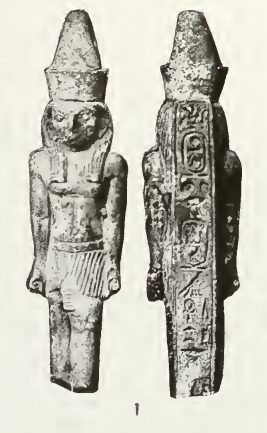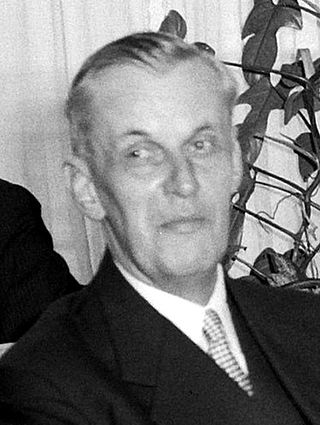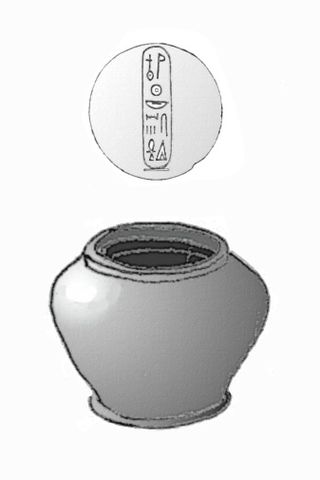
Imhotep was an Egyptian chancellor to the Pharaoh Djoser, possible architect of Djoser's step pyramid, and high priest of the sun god Ra at Heliopolis. Very little is known of Imhotep as a historical figure, but in the 3,000 years following his death, he was gradually glorified and deified.

Hermes Trismegistus is a legendary Hellenistic period figure that originated as a syncretic combination of the Greek god Hermes and the Egyptian god Thoth. He is the purported author of the Hermetica, a widely diverse series of ancient and medieval pseudepigraphica that lay the basis of various philosophical systems known as Hermeticism.

Thoth is an ancient Egyptian deity. In art, he was often depicted as a man with the head of an ibis or a baboon, animals sacred to him. His feminine counterpart was Seshat, and his wife was Ma'at. He was the god of the Moon, wisdom, knowledge, writing, hieroglyphs, science, magic, art and judgment.

Nu or Nun, in ancient Egyptian religion, is the personification of the primordial watery abyss which existed at the time of creation and from which the creator sun god Ra arose.

Ḥeḥ was the personification of infinity or eternity in the Ogdoad in ancient Egyptian religion. His name originally meant "flood", referring to the watery chaos Nu that the Egyptians believed existed before the creation of the world. The Egyptians envisioned this chaos as infinite, in contrast with the finite created world, so Heh personified this aspect of the primordial waters. Heh's female counterpart was known as Hauhet, which is simply the feminine form of his name.
Renpet was, in the Egyptian language, the word for "year". Its hieroglyph was figuratively depicted in art as a woman wearing a palm shoot over her head. She was often referred to as the Mistress of Eternity and also personified fertility, youth and spring. The glyph regularly appears on monuments and documents throughout Egyptian history as the beginning of the phrase recording the regnal year of the pharaoh.

Seshat was the ancient Egyptian goddess of writing, wisdom, and knowledge. She was seen as a scribe and record keeper; her name means "female scribe". She is credited with inventing writing. She also became identified as the goddess of sciences, accounting, architecture, astronomy, astrology, building, mathematics, and surveying.

Menkheperre Necho I was a ruler of the ancient Egyptian city of Sais. He was the first securely attested local Saite king of the 26th Dynasty of Egypt who reigned for 8 years (672–664 BCE) according to Manetho's Aegyptiaca. Egypt was reunified by his son Psamtik I.

This is an index of Egyptian mythology articles.

The Famine Stela is an inscription written in Egyptian hieroglyphs located on Sehel Island in the Nile near Aswan in Egypt, which tells of a seven-year period of drought and famine during the reign of pharaoh Djoser of the Third Dynasty. It is thought that the stele was inscribed during the Ptolemaic Kingdom, which ruled from 332 to 31 BC.
Thinis was the capital city of pre unification Upper Egypt. Thinis remains undiscovered but is well attested by ancient writers, including the classical historian Manetho, who cites it as the centre of the Thinite Confederacy, a tribal confederation whose leader, Menes, united Egypt and was its first pharaoh. Thinis began a steep decline in importance when the capital was relocated to Memphis, which was thought to be the first true and stable capital after the unification of Egypt by Menes. Thinis's location on the border of the competing Heracleopolitan and Theban dynasties of the First Intermediate Period and its proximity to certain oases of possible military importance ensured Thinis some continued significance in the Old and New Kingdoms. This was a brief respite and Thinis eventually lost its position as a regional administrative centre by the Roman period.

Amenhotep, son of Hapu was an ancient Egyptian architect, a priest, a scribe, and a public official, who held a number of offices under Amenhotep III of the 18th Dynasty.

Dumuzid, titled the Fisherman, was a legendary Sumerian king of Uruk listed originating from Kuara. According to legend, in the one-hundredth year of his reign, he was captured by Enmebaragesi.

Ramose was an ancient Egyptian scribe and artisan who lived in Deir el-Medina on the west bank of the Nile, opposite Thebes, during the reigns of Ramesses II. He held the position of Scribe of the Tomb, the highest administrative position for a scribe in Deir el-Medina, from around years 5 to 38 of Ramesses II's reign. He was buried in a tomb in the village necropolis.

Robert Jacobus Forbes or Robert James Forbes was a Dutch chemist and historian of science and professor in the history of applied science and technology at the University of Amsterdam.
Inaros I of Athribis was an ancient Egyptian prince who rebelled against the Assyrians during their short-lived occupation of Egypt. His struggle against the Assyrians gave rise to a whole cycle of stories, known as The Inaros Stories, the latest of which date to the 2nd century AD, about 750 years after his death.

The Netherlands Institute for the Near East is an institution for the advancement of the study of the Ancient Near East, Mesopotamia, Anatolia, and Egypt. It is an independent foundation with close ties to Leiden University, housed at the Faculty of Humanities. The institute was founded in 1939. In 2017 the board of NINO decided to integrate the library into Leiden university and to transform the institute to a pure "research school".

Nebsenre was an Egyptian pharaoh of the 14th Dynasty of Egypt during the Second Intermediate Period. Nebsenre reigned for a least five months over the Eastern and possibly Western Nile Delta, some time during the first half of the 17th century BCE. As such Nebsenre was a contemporary of the Memphis based 13th Dynasty.
Grant Frame is a Canadian-American Assyriologist, Professor Emeritus of the University of Pennsylvania, and Curator Emeritus of the Babylonian Section of the University of Pennsylvania Museum of Archaeology and Anthropology. He is an expert on Akkadian language and literature and on the history and culture of ancient Mesopotamia in the first millennium BCE, in particular the Neo-Assyrian and Neo-Babylonian periods. Since 2008, he has served as Director and Editor-in-Chief of The Royal Inscriptions of the Neo-Assyrian Period (RINAP), an international research project funded by the U.S. government's National Endowment for the Humanities and other granting agencies, to translate the royal inscriptions of the rulers of Assyria from 744 to 609 BC. The RINAP project marks the continuation of the Royal Inscriptions of Mesopotamia (RIM) project, which Frame's teacher and mentor, Albert Kirk Grayson, founded at the University of Toronto in 1978 and led until his retirement with support from the Social Sciences and Humanities Research Council of Canada.
















